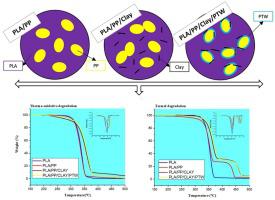当前位置:
X-MOL 学术
›
Thermochim. Acta
›
论文详情
Our official English website, www.x-mol.net, welcomes your feedback! (Note: you will need to create a separate account there.)
Influence of polypropylene and nanoclay on thermal and thermo-oxidative degradation of poly(lactide acid): TG-FTIR, TG-DSC studies and kinetic analysis
Thermochimica Acta ( IF 3.5 ) Pub Date : 2020-09-01 , DOI: 10.1016/j.tca.2020.178709 Navid Karimpour-Motlagh , Hossein Ali Khonakdar , Seyed Mohammad Ali Jafari , Alireza Mahjub , Mahyar Panahi-Sarmad , Sina Farahani Kasbi , Shahrokh Shojaei , Vahabodin Goodarzi , Mohammad Arjmand
Thermochimica Acta ( IF 3.5 ) Pub Date : 2020-09-01 , DOI: 10.1016/j.tca.2020.178709 Navid Karimpour-Motlagh , Hossein Ali Khonakdar , Seyed Mohammad Ali Jafari , Alireza Mahjub , Mahyar Panahi-Sarmad , Sina Farahani Kasbi , Shahrokh Shojaei , Vahabodin Goodarzi , Mohammad Arjmand

|
Abstract Compatibilized poly(lactic acid)/polypropylene (PLA/PP) blends with a drop-matrix morphology containing 25 wt.% PP, 5 wt.% ethylene/n-butyl acrylate/glycidyl methacrylate terpolymer (PTW) as compatibilizer, and 5 wt.% nanoclay were prepared by one-step mixing process in a twin-screw extruder. TEM analysis revealed that the clay particles were mainly localized in the PLA matrix phase in the absence of PTW; by contrast, the addition of compatibilizer changed the location to the blend interface. Multiple rate thermogravimetric analysis revealed two-stage and single-stage weight losses under neutral and air atmospheres, respectively. To reveal the influence of blending, nanoclay inclusion and compatibilization process on the PLA degradation process, a systematic quantitative evaluation of degradation processes was carried out based on kinetic parameters derived from model-free and model-fitting analyses. The results revealed that the activation energy of the thermo-oxidative process, being significantly lower than that of the thermal pyrolysis, greatly increases in the presence of nanoclay, indicating the accelerating role of oxygen in the degradation process and the barrier effect of nanoclay against oxygen diffusion. The combined TG-DSC analysis in the nitrogen environment confirmed the appearance of endothermic signals being proportional to the sample weight loss, which is characteristic of thermal pyrolysis. Subsequently, in an oxygen-containing environment, initial exothermic peaks were formed, which was attributed to the oxidative degradation of the sample. As the reaction progressed, secondary peaks were observed due to the degradation of residuals formed in the first stage of the degradation process. Also, for chemical analysis of volatiles, simultaneous TG-FTIR analysis was employed in a neutral atmosphere at the maximum degradation temperature. Lactide, acetaldehyde, carbon dioxide (CO2) and carbon monoxide (CO) were the products obtained from the degradation process of the PLA phase.
中文翻译:

聚丙烯和纳米粘土对聚丙交酯热和热氧化降解的影响:TG-FTIR、TG-DSC 研究和动力学分析
摘要 相容的聚乳酸/聚丙烯 (PLA/PP) 共混物具有滴状基质形态,含有 25 wt.% PP、5 wt.% 乙烯/丙烯酸正丁酯/甲基丙烯酸缩水甘油酯三元共聚物 (PTW) 作为增容剂和 5 wt.% 纳米粘土在双螺杆挤出机中通过一步混合工艺制备。TEM 分析表明,在没有 PTW 的情况下,粘土颗粒主要位于 PLA 基体相中;相比之下,增容剂的添加改变了混合界面的位置。多速率热重分析分别揭示了在中性和空气气氛下的两级和单级重量损失。为了揭示共混、纳米粘土夹杂和增容过程对 PLA 降解过程的影响,根据从无模型和模型拟合分析得出的动力学参数,对降解过程进行了系统的定量评估。结果表明,在纳米粘土存在下,热氧化过程的活化能明显低于热解的活化能,显着增加,表明氧在降解过程中的加速作用和纳米粘土对氧的阻隔作用。扩散。在氮气环境中的组合 TG-DSC 分析证实了吸热信号的出现与样品重量损失成正比,这是热解的特征。随后,在含氧环境中,形成初始放热峰,这归因于样品的氧化降解。随着反应的进行,由于在降解过程的第一阶段形成的残留物的降解,观察到二次峰。此外,对于挥发物的化学分析,在最大降解温度下在中性气氛中采用同步 TG-FTIR 分析。丙交酯、乙醛、二氧化碳 (CO2) 和一氧化碳 (CO) 是从 PLA 相的降解过程中获得的产物。
更新日期:2020-09-01
中文翻译:

聚丙烯和纳米粘土对聚丙交酯热和热氧化降解的影响:TG-FTIR、TG-DSC 研究和动力学分析
摘要 相容的聚乳酸/聚丙烯 (PLA/PP) 共混物具有滴状基质形态,含有 25 wt.% PP、5 wt.% 乙烯/丙烯酸正丁酯/甲基丙烯酸缩水甘油酯三元共聚物 (PTW) 作为增容剂和 5 wt.% 纳米粘土在双螺杆挤出机中通过一步混合工艺制备。TEM 分析表明,在没有 PTW 的情况下,粘土颗粒主要位于 PLA 基体相中;相比之下,增容剂的添加改变了混合界面的位置。多速率热重分析分别揭示了在中性和空气气氛下的两级和单级重量损失。为了揭示共混、纳米粘土夹杂和增容过程对 PLA 降解过程的影响,根据从无模型和模型拟合分析得出的动力学参数,对降解过程进行了系统的定量评估。结果表明,在纳米粘土存在下,热氧化过程的活化能明显低于热解的活化能,显着增加,表明氧在降解过程中的加速作用和纳米粘土对氧的阻隔作用。扩散。在氮气环境中的组合 TG-DSC 分析证实了吸热信号的出现与样品重量损失成正比,这是热解的特征。随后,在含氧环境中,形成初始放热峰,这归因于样品的氧化降解。随着反应的进行,由于在降解过程的第一阶段形成的残留物的降解,观察到二次峰。此外,对于挥发物的化学分析,在最大降解温度下在中性气氛中采用同步 TG-FTIR 分析。丙交酯、乙醛、二氧化碳 (CO2) 和一氧化碳 (CO) 是从 PLA 相的降解过程中获得的产物。


























 京公网安备 11010802027423号
京公网安备 11010802027423号